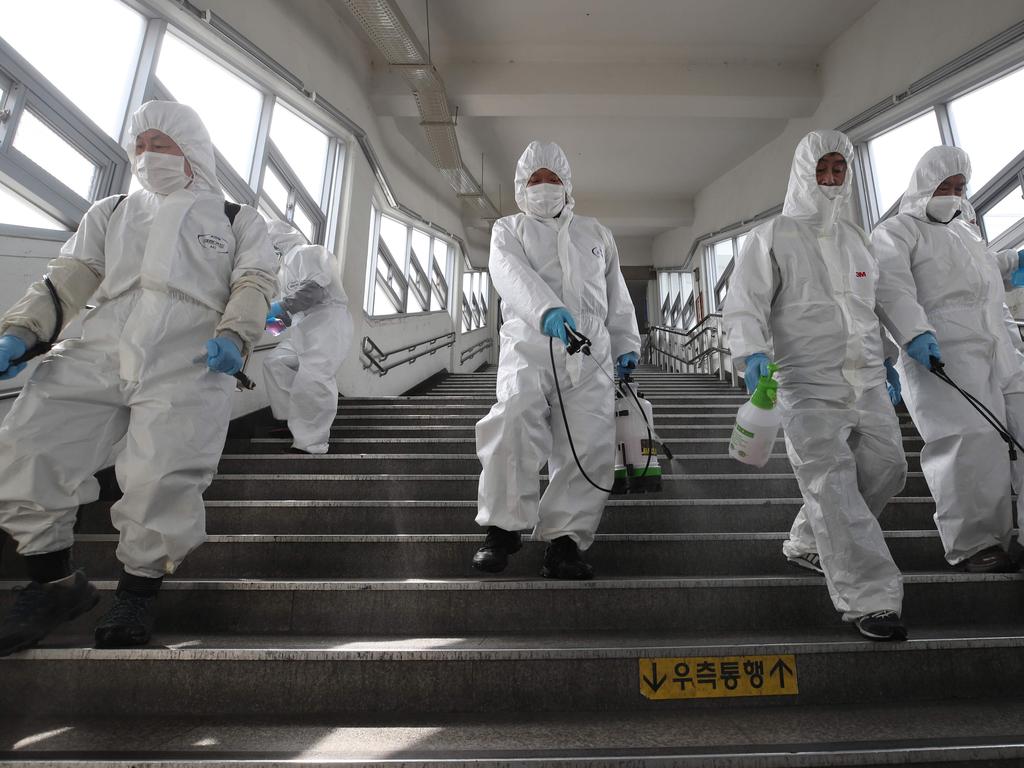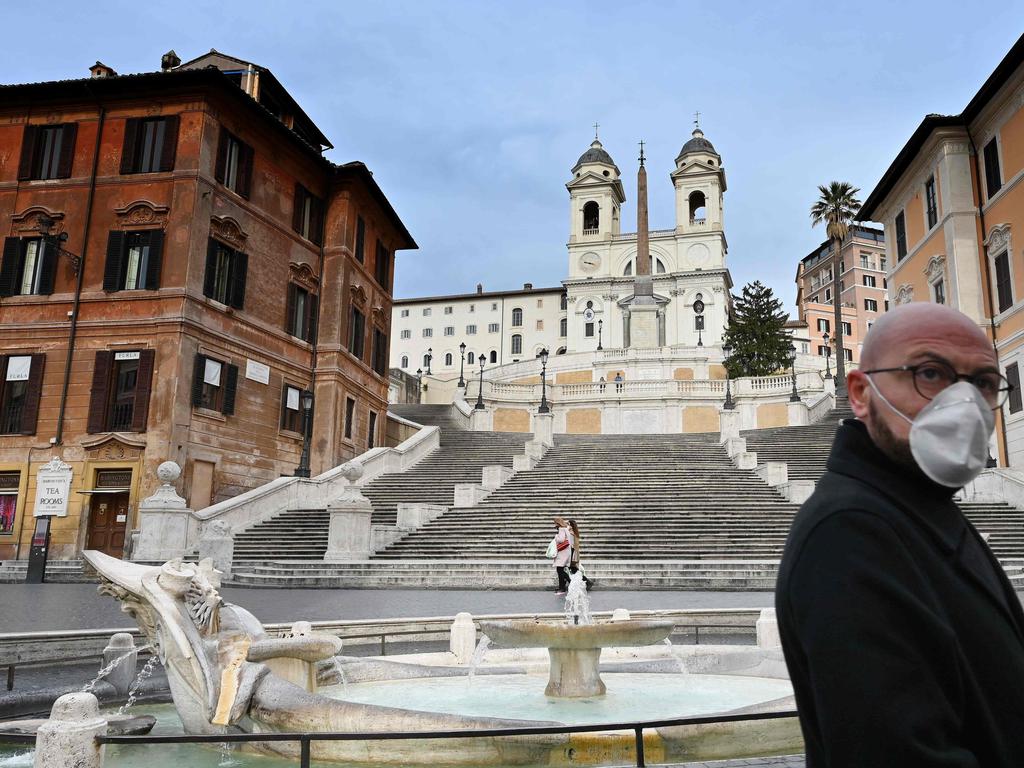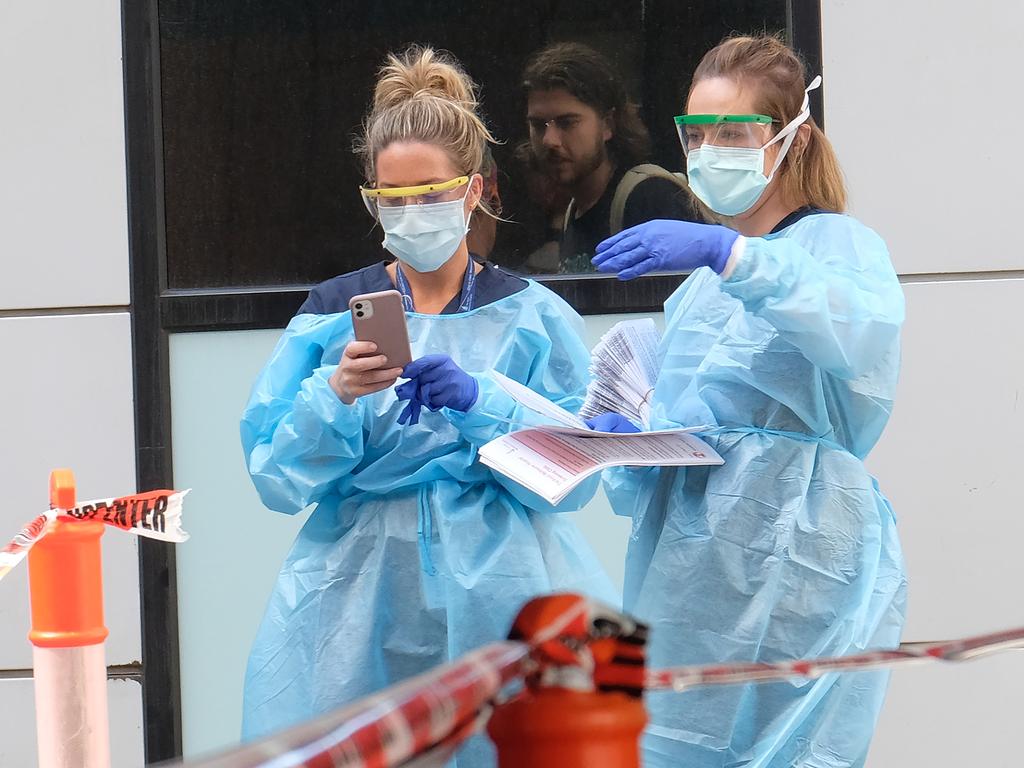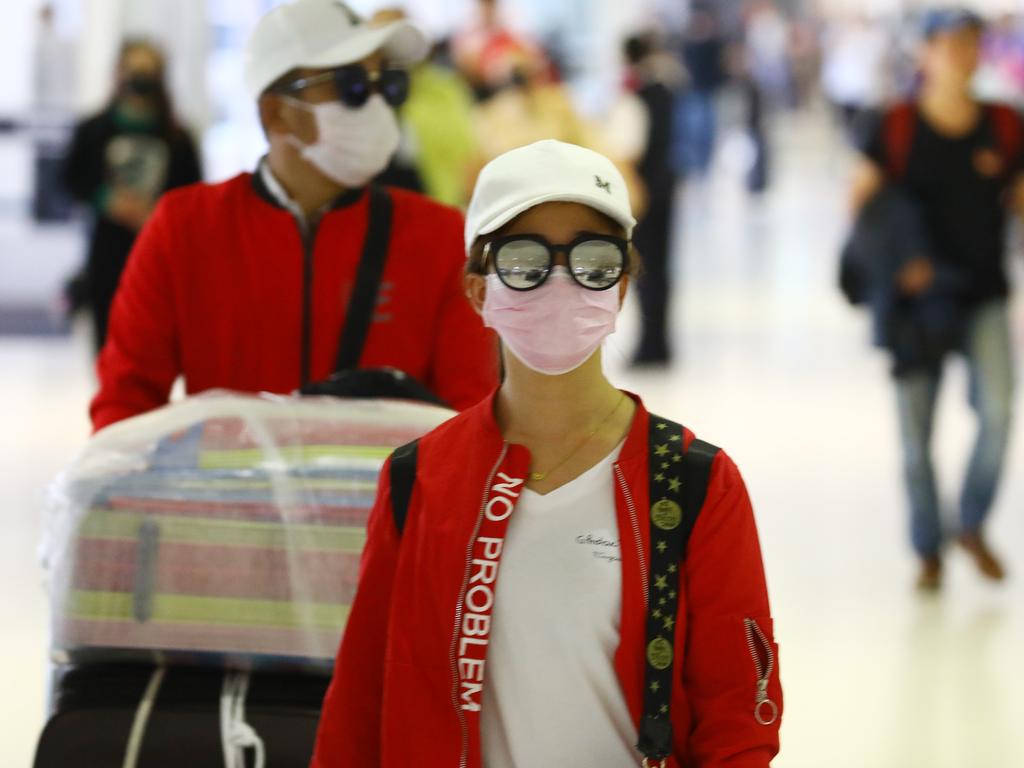Coronavirus: Alarming disparity in Italy and South Korea virus deaths
Coronavirus hit Italy and South Korea at the same time – but the difference between the death tolls says something terrifying about Australia’s future.

ANALYSIS
What difference does one day make? In the case of responding to coronavirus, it’s massive. When the illness explodes into view, it’s already too late. Which is why early action is necessary.
COVID-19 is rewriting the rules of epidemiology.
Like all viruses, it is multiplying at exponential speeds. In this case, the number of infected can double roughly every six days.
That makes it nasty enough as it is.
Problem is, it takes about the same amount of time for symptoms to appear.
During that six days, those infected are unknowingly spreading the virus. But they feel fine. So they go to the football, the rugby, the Grand Prix …
And that’s why Australia’s Chief Medical Officer Brendan Murphy has taken the dramatic action of recommending all non-essential gatherings of over 500 people after Monday cancelled.
Prime Minister Morrison agreed it was time to act.
“There will be many issues to work through between now and Monday as we get the precise advice about the implementation of that advice to Australians around the country,” the PM said.
“What we are announcing today is just another step. It is precautionary. It is getting ahead of this to ensure that we can minimise the impact on your health and we can ensure with confidence the ability for people to be accessing the health services that they and their families will need.”
As the examples of Italy and South Korea show, recognising this makes all the difference.
Milan and Seoul discovered their first cases about the same time a month ago.
Today, Italy is in total lockdown, with 15,113 cases of COVID-19 with 1016 deaths. That’s a case fatality rate of 6.7 per cent in one of the largest economies in the European Union.
South Korea, despite experiencing an early ‘superspreader’ event through a religious cult, only has a few thousand under quarantine, 7900 known cases and 67 fatalities.
How Australia acts now will determine what our future holds. And public pressure has been mounting.
Victorian Australian Medical Association (AMA) President Julian Rait this morning called for all major sporting events and gatherings to be cancelled – including Melbourne’s Grand Prix.
“History indicates in the acceleration of an epidemic if large public gatherings are contained, it’s more likely you’ll be able to reduce the spread of infection and the consequent fatality rate,” Associate Professor Rait said. “The unfortunate lessons of history are such while it’s all very well to believe things are contained in the context of viral outbreaks, often things behave very differently.”
This afternoon, his wishes have been granted.
“There is early evidence of community transmissions – very few cases, not widespread,” Professor Murphy said at a press conference this afternoon. “We are still not saying that there is a significant risk to all to the Australian community. But all international evidence suggests that if you have some community transmission, the way in which it can be spread more rapidly is through very large events.”
HE WHO HESITATES …
Italy and China have shown us that, by the time the first wave of seriously ill appears, coronavirus is already well and truly entrenched.
In contrast, the likes of South Korea and Japan have demonstrated the immense value of decisive, pre-emptive action.
Italy did not enforce widespread testing. By Thursday, only 73,000 tests had been conducted on its population of 60 million. While this was designed to reduce the cost and strain on medical services, epidemiologists believe it has backfired.
The country is now in total lockdown. They don’t know where the disease is. They can’t predict what’s coming. All they can do is hope the blanket effect of social distancing will, eventually, turn the crisis around.
South Korea took the opposite approach. Its government immediately began testing 10s of thousands of its 50 million people for the infection.By Thursday more than 220,000 tests had been applied. It then followed-up by tracking where the infected had been - and put those areas under lockdown.
On Thursday, Italy had 827 dead. Two days later, that toll is 1016.
South Korea had 66. Two days later, that toll is 67.
Similar populations. Similar time periods. Similar health systems. That’s the difference early, decisive action makes.
RELATED: Get the latest coronavirus updates here
RELATED: Fury as Melbourne Grand Prix called off

STEADY AS SHE GOES?
Prime Minister Scott Morrison’s had until today been almost entirely on mitigating the pandemic’s looming economic impact.
We know that will be bad.
Until now, however, there hadn’t been a firm government public health message.
Leaving it much longer would have been a problem.
Coronavirus won’t be much worse than a mild flu for the bulk of the population. But its effect on the elderly and those with pre-existing conditions such as diabetes and cardiovascular disease will be much more severe.
Requesting our leaders @ScottMorrisonMP @DanielAndrewsMP @AnnastaciaMP @GladysB
— Adam Kamradt-Scott (@adamkams) March 12, 2020
Pls stop describing public health measures such as quarantine, social distancing, etc as "extreme".
They may be unusual or rare, but language like "extreme" simply increases public anxiety.
Epidemiologists believe the COVID19 fatality rate is about 0.5 to 0.9 per cent - under an adequately resourced and functional health system (for flu, it’s 0.1 per cent). Where that system fails or is not available, it leaps to over 3.5 per cent - or worse.
Australia has some 62,000 hospital beds, in total. Coronavirus appears to have a 15-20 per cent hospitalisation rate. Translated, that means every Australian hospital bed will be needed if 310,000 people come down with the disease.
That’s not counting those already occupying those beds.
Add to the mix expectations that some 4.7 per cent of sufferers will need intensive care. About one per cent will need ventilators to keep them alive.
This is why, as early as Tuesday, Sydney emergency doctor Cathie Hull called for immediate, extreme measures to tackle COVID19’s spread.
RELATED: 31,000 Chinese students arrive after ban
RELATED: Shocking photo of virus killing patient

BREATHING SPACE
Dr Hull was among the first to call for the introduction of “social distancing” politics.
“(Social distancing will) give us all some breathing space – for the health system to get used to what works best, how we can protect our workers, how we can best set things up to have enough hospital capacity for the people that are going to be sick,” she said on Tuesday. “We could reduce the pool of infections for a period of time. We might slow the spread.”
Lots of science-y folks are posting this graph. But if there is one thing I have learned from being on the internet, it is this:
— Anne Marie Darling (@amdar1ing) March 11, 2020
Data/graphs: Not compelling to many.
Kitties: Compelling to many.
So I present: #Catteningthecurve.#scicomm #epitwitter pic.twitter.com/Cr1xQXMppr
At the time, Professor Murphy was not convinced. He dismissed the appeal at a news conference that same day.
“Our advice is we’re not at that stage,” Professor Murphy said. “If we had more sustained community transmission, then we wouldn’t hesitate to make recommendations about public gatherings, schools and the like. We only had that one issue of community transmission in Ryde. I can imagine how the doctor would feel motivated to do more strenuous measures. But we are reviewing this every single day.”
This morning, West Australian AMA President Andrew Miller also has called on the federal government to detail what it will do to cope with the virus’ impact on health. “It’s beyond time for the government to tell us what the plan is, what date they’re going to do this, depending on how many cases they see,” Dr Miller told the ABC.
RELATED: Cancel everything – expert slams PM
RELATED: How world has responded to virus

DEATH BY NUMBERS
Dr Hull was worried that the first known case of coronavirus in Sydney’s community was just the tip of a rapidly inflating, invisible iceberg. Some have not sought testing as their symptoms are mild. Then there are all those who have been infected but are counting down the days before symptoms appear.
And Dr Hull has personal experience of this: She’s under self-isolation after coming into contact with an infected colleague.
“We don’t have a vaccine. We don’t have any direct treatment … To stop it, we only have barriers like isolation,” she said.
At this point, the apparently low number of infections and fatalities in Australia may be giving politicians and bureaucrats a sense of security.
Exponential growth is not a concept that comes naturally. Which is why its outcomes are often so surprising.
Coronavirus doubles every six days. This means the 150 known to be sick in Australia now could be about 300 next Thursday, 600 the following Wednesday and 1200 by Tuesday, March 31. That number will keep doubling until there are no longer any people to infect, or measures are put in place to slow it.
Unimpeded, that means 310,000 Australians could be infected within 11 weeks. And those numbers are at least a week behind at the time they are generated.
Such rough numbers are highly speculative. Only up-to-date and accurate statistics applied to fully inclusive epidemic modelling can give a reliable result.
Australia needs those statistics. And independent analysis of them.
But most tests are being reserved for those who have travelled internationally, or come in contact with sick travellers.
So when you combine that with exponential growth in the broader community, and there’s trouble ahead.
THE FIRST WAVE ILLUSION
On January 21, China thought it had 100 new cases of the emerging disease. But, a review of patient accounts has since revealed that figure was closer to 1500.
Just two days later, authorities shut down the entire city of Wuhan, ordering its 11 million residents to lock themselves indoors.
The day this decision was taken, 400 new cases had been detected. But, a subsequent review of patient data reveals that number was – in reality – 2500.
They just didn’t know it.
Which is why, two days later, 15 more cities in Hubei province were put into lockdown. Cases there seemed to be unexpectedly exploding, too.
That’s because COVID-19 had used the mask of its five to 14-day infectious incubation period to leap far ahead of government statistics.
Beijing curtailed the virus through drastic measures. That same draconian approach, however, has left a pall of doubt over its claims to have halted the disease.
But fast action in South Korea, Japan – all the nations that were scared into action by SARS in 2009 – proves targeted isolation also makes a dramatic difference.
This is why epidemiologists and virologists the world over are calling for urgent social distancing action. Wherever you are, things are almost certainly already worse than they seem.
But politicians worried about their economic bottom lines are hesitating.
RELATED: Virus fears rip through Channel 9
RELATED: Fears 1.2m infected in NSW’s ‘first wave’

TROUBLE AHEAD
The US has, for reasons of bureaucracy, politics and bungled kit production, been conducting minimal testing of its population for coronavirus. Which means the extent of its numbers spread is unknown.
But every six days, the caseload continues to double quietly.
Soon, the US health system will face a storm of hospitalisations.
Again, the extent of the impact comes down to maths.
Meanwhile, the number of infected reported in the US is, at the moment, meaningless. Even those hospitalised with COVID-19 symptoms are not being tested due to the kit shortage crisis.
And there is a looming international shortage of the chemicals needed to manufacture those kits.
Clinical advice from AMA Vice President, Dr Chris Zappala, on testing and initial assessment of #COVID_19 patients available on AMA website https://t.co/H7Qxm2jWPt
— AMA Media (@ama_media) March 12, 2020
Today, the state and federal governments agreed COVID19 has broken into Australia’s general community. That means it’s spreading, fast.
Professor Murphy emphasised Australia was striving to stay ahead of the disease.
“The risk to the Australian community in general still remains low,” he said. “Most of our cases still are imported, but we know that some of those imported cases have led to some community spread. We want to be as far ahead of the game as any country, control the spread of this virus and make sure that we keep its outbreaks in Australia as limited as possible.
Jamie Seidel is a freelance writer | @JamieSeidel



